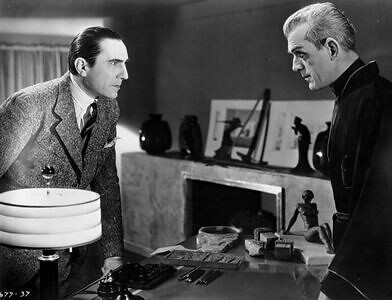Edgar G. Ulmer's "The Black Cat" is nothing like the Poe classic, there is barely a feline in sight for most of the movie! But what is there is a majestic chess game, literally and figuratively, between two horror greats Boris Karloff and Bela Lugosi. Lugosi's Dr. Vitus Werdergast is on a train to Hungary from a prison camp to meet his "old friend" Hjalmar Poelzig. But a chance meeting with honeymooners Peter (David Manners) and Joan (Jacqueline Wells) leads them to share a car which crashes just a few miles from Poelzig's home. Joan is injured and taken into the sharply modern mansion where Poelzig and Werdergast finally face off, resulting in a Satanic ritual, Werdergast's own Ailurophobia, and a few deaths.
Lugosi is in rare form as an antihero for
"The Black Cat" could only be called a visceral film from never seeing how Werdergast enacts his revenge or any overt Satanist allusion. Having gained "complete freedom" from Universal Studios, Ulmer and writer Peter Ruric went crazy after taking more creative liberties from Ruric's original faithful mix of the short story blended with "The Fall of the House of Usher." "Ulmer's "complete freedom" came to a screeching halt when Universal Execs saw the filmed footage and script. Lugosi's hero rapes the heroine, the heroine occasionally turns into a black cat, and Karloff's Poelzig is skinned alive and last seen crawling on the floor with his skin hanging from his body as Lugosi's mad hero laughs hysterically . All of these scenes were cut from the film and par axed
What is lacking instory cinema, which
What is lacking in








No comments:
Post a Comment